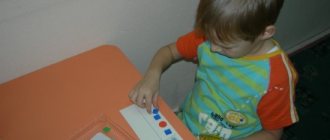Surely you have met children who have difficulty reading or pronouncing sounds, letters, and words. In early childhood it is too early to talk about the problem, but there are certain signals that should alert you. Unnoticed pathologies in preschool children can lead to negative consequences and cause difficulties in school learning and even in relationships with peers. In some cases, we can talk about dyslexia. We suggest you look into the issue in more detail.
Mechanisms of dyslexia
- Violations of operational phonological memory, that is, the ability to briefly retain read segments of speech (sounds, letters, syllables, words) in operative memory.
- Violation of the serial organization of the reading process. The child has difficulty remembering a series of signs, meanings, and concepts. The ability to learn to perceive a syllable as a whole, and not letter by letter, is a serially organized process.
- Insufficient vocabulary. Poor vocabulary hinders the development of reading and comprehension skills. On the other hand, at school age, the vocabulary is replenished precisely from the books read.
- Slowness in recalling known words.
- Low ability to automate skills, requiring constant repetition of the mastered skill over a long period of time.
- Increased fatigue, asthenia of the child.
- Impaired concentration.
The main manifestations of dyslexia depend on the writing characteristics of a particular language. Some children experience difficulties at the stage of learning the primer, that is, mastering sound-letter connections. When learning to read, you should go from sound to letter, so learning the names of letters, for example, using cubes, is pointless. Russian-language writing requires, first of all, the development of the skill of merging letters into syllables, the absence of which is a critical barrier in the formation of reading skills. The peculiarity of mastering reading skills is such that until the child has achieved automaticity of sound-letter connections, he will not be able to master syllable fusion. As a result, such children lack actual technical skills; syllabic reading is not automated, and even after graduating from secondary school, the child actually retains letter-by-letter reading. The persistence of the condition is such that it can persist throughout life in the absence of qualified speech therapy assistance.
In addition, dyslexia can manifest itself as reading comprehension impairment, when technical reading skills are developed, but the reader does not understand what is read despite normal cognitive abilities.
Diagnosis and correction of childhood dyslexia
The speech therapist studies the history of life and development, features of speech formation, the state of the articulatory apparatus and motor skills. In preschool children, sound pronunciation, speech coherence, and the ability to perceive oral speech are assessed. Schoolchildren are examined for their writing skills, reading speed, and performance in various subjects.
According to indications, consultations with a neurologist, ophthalmologist, electroencephalogram, echoEG, and ophthalmological tests are prescribed. The choice of correction methods depends on the form of the pathology and its neglect. Traditionally, speech therapists conduct special classes.
Exercises for dyslexia
The goal is to eliminate defects in sound pronunciation, form grammatical word formation systems, develop speech hearing, and improve visual-spatial concepts:
- "Find the word." We offer to find all objects starting with a given letter, over time we complicate it and look for things whose names do not begin, but end with a certain sound;
- "Make words." We make separate words from magnetic letters “glued” to each other. For example, you need to separate “MOM GRANDMOTHER DADDY”;
- “Write the word.” Have the dyslexic read the word and write it from memory. We gradually complicate it by adding phrases;
- “Fix the sentence.” Offer to create a phrase from the mixed cards with written words. For preschool children, you can adapt it like this: make words from cards with syllables;
- “Take a guess.” All the guys love this exercise. Draw letters, syllables, words on the child’s back, and let him guess them;
- "Word Game" Take turns with the student to name words that begin with the last letter of the previous word. For example, “mother-atlas-owl-album-car”;
- “Counting the sounds.” Prepare some pasta and a cup. Name the words and offer to place in front of you as much pasta as there are sounds in the word;
- "Cute names." Let the baby affectionately name the words you said. Examples: table-table, car-typewriter, cat-cat.
You can use your imagination and come up with your own games and exercises that your child will enjoy and benefit from.
School learning difficulties caused by dyslexia
In the first grade, children with dyslexia lag behind their classmates in terms of the pace of mastering sound-letter connections, since their alphabetic period lasts about a year, whereas normally it barely reaches six months.
The lack of formation of automaticity of sound-letter connections leads to disturbances in syllable fusion, which significantly impairs reading technique and impedes understanding of what is read. This phenomenon underlies the child’s “lag” in most school subjects that require reading skills.
The more discretely a child reads, the greater the load on working memory, which is initially less functional. This reduces the speed and quality of reading.
The child fails to timely enlarge reading units that are perceived holistically, starting from two-letter syllables and ending with a complete word. It is this process that is called the main line of reading and its development is the main target of the efforts of parents, teachers and speech therapists.
Part of the textual material is usually not read, but is guessed by the reader, which is the normal reading mechanism. At the same time, the reader controls the correctness of such guesses. However, poor vocabulary and weak self-control in children with dyslexia reduce the accuracy of such “guessing”, leading to errors that make it difficult to understand the text. Guessing normally occurs at the level of phrases and text, but with dyslexia, a syllable is guessed, which interferes with normal reading. Children, unable to merge a syllable, try to guess it, making many mistakes. The correction program in this case is focused on the formation of control over the reading result, focusing on the semantic context. In this case, guessing will be a positive component of reading skill.
Results of manifestations of dyslexia:
- decline in academic performance;
- decreased child self-esteem;
- formation of “reading phobia” and “school learning phobia”;
- disruption of the socialization process.
Timely provision of specialized speech therapy assistance helps prevent neuroticism in the child and his parents, normalize self-esteem and achieve academic performance in school subjects. It is a mistake to base a child’s assessment on his success at school, but this mistake is made by parents and teachers everywhere. For children with dyslexia, this is critical. Therefore, to successfully master the dyslexia correction program, it is necessary to create and maintain high motivation for classes, avoiding harsh coercion.
Cause of dyslexia in a child
Brain dysfunction accompanied by biological or psychological factors is the main cause of dyslexia. With dyslexia, a child has a disorder of verbal speech, difficulties with writing and understanding written language, which in the future can lead to problems with memorization.
But this does not mean that the cause of the disorder is an intellectual or mental disability in the child.
The cause of the occurrence lies in the underdevelopment of the posterior part of the temporal gyrus of the left hemisphere, which is responsible for the perception of information when reading. It is simply impossible to predict the occurrence of dyslexia in a child; this disease can be hereditary. The presence of certain genes in the body affects the occurrence of this disorder.
Recommendations for parents
Parents who want to help their child can and should create conditions for the successful development of reading skills at home. These include the following fundamental points:
- Providing ongoing psychological support to a child suffering from dyslexia. The unconditional acceptance of the child and his value to the family, regardless of his level of performance, should be constantly demonstrated. A child should not be scolded for poor reading, trying to abstract himself from his own unfulfilled expectations.
- To help your child, you need to read aloud to him the texts required by the program, because this way he understands them better. In addition, this reduces the overall workload, which is too high for such children. These can be either textbook texts or fiction. This facilitates the assimilation of material in the subjects of the school curriculum, ensures the expansion of vocabulary, and prevents the formation of “reading phobia.” Reading aloud to a child (to parents or teachers) is beneficial for children of any age, especially those with dyslexia. Reading aloud at home (when the parent reads) fiction with joint discussion of what has been read is a very important work with which the parent will provide real help to the child. Interest in what you read will also help increase motivation for correctional classes to develop your own reading skills.
- Don't force your child to read out loud. Reading aloud does not contribute to progress in the formation of meaningful reading skills, but is more labor-intensive than silent reading. For many children with dyslexia, it is easier to read “to themselves,” which also facilitates understanding of what they read and semantic analysis of the text. This recommendation has scientific basis. Scientific research from our laboratory, during which the gaze movements of children with dyslexia were recorded while reading text, showed the following. Every reader from time to time returns to an already read part of the text and rereads it. When reading aloud, this becomes impossible, which means it limits reading comprehension.
- It is useful to talk with your child as much as possible, and in the process of reading together, clarify unfamiliar words. This improves understanding of the text and helps expand vocabulary. You need to encourage your child to ask questions about unfamiliar words when he reads or listens, and praise him for this.
- Introduce correspondence with your children on any everyday topics into the practice of your family life. This is convenient to do on the Internet, in instant messengers. You need to start from 1st grade. Correspondence is needed daily, with a gradual expansion of the volume of text. This promotes the child's perception of writing and reading as important skills in everyday life, and not just at school.
The implementation of these recommendations must be combined with specialized speech therapy assistance, including in a remote format.
Methodological basis of the program for remote correction of dyslexia
The method of teaching reading embedded in the software of the SLOGY online platform is the result of almost 30 years of research conducted in the laboratory of neurocognitive technologies of St. Petersburg State Pediatric Medical University under the guidance of Professor Alexander Nikolaevich Kornev, the founder and scientific director of the project.
Back in the late 80s, Professor, Doctor of Psychology Alexander Nikolaevich Kornev developed his own semi-global method of teaching reading, an alternative to the traditional analytical-synthetic method, which is used in secondary schools. The method is based on an alternative method of teaching reading, which relies on the intact abilities of children with reading disabilities and has been successfully tested in working with children with dyslexia, children with mental retardation and children with oral speech underdevelopment.
A special feature of this method is its reliance on involuntary memorization of syllables and words, which is rarely used in the school curriculum. The child remembers the basic set of syllables of the Russian language, correlating graphic and sound (oral) syllables. This ability is preserved in children with dyslexia, so learning to read is easier to endure and the result is achieved more successfully.
Experience shows that it is more interesting and easier for children to work with Internet resources when reading from a monitor. Daily work in the program does not exceed 10 minutes, which ensures an acceptable load on vision, maintaining the necessary concentration and motivation for long-term activities necessary for the formation of sustainable reading skills.
The SLOGY online platform was developed specifically for the Russian language and has no analogues in the world. For children with persistent reading disabilities - that is, dyslexia and related learning difficulties - this is the only opportunity to get help anywhere in the world, without leaving home.
How does the reading process happen?
Normally, different functional areas are involved in the reading process. First of all, these are analyzers responsible for the perception of visual information, reproduction and sound perception of speech: visual, speech motor and speech auditory. They are activated sequentially, so reading can be divided into several stages:
- Visual perception, recognition and discrimination of letters.
- Matching visible letters with corresponding sounds.
- Merging perceived sounds into syllables.
- Combining syllables into a word and words into a sentence.
- Comprehension of information read.
How the program works
The program is a set of game-based training exercises used interactively. Over a long period of time, the child performs these exercises, which leads to the formation of the basic skills necessary for mastering reading. Cloud technologies make it possible to ensure accessibility, systematicity and regularity of classes, which are a prerequisite for the effectiveness of the method. Since automation occurs slowly in children with dyslexia, not a single day should be missed. In this regard, the role of parents is to motivate the child, remind him of the need for regular classes and encourage him, emphasizing his successes, even if they are still small.
The software package includes a diagnostic module that allows you to select an individual mode and level of difficulty of exercises. This module evaluates in real time throughout the entire training period the success of developing the components of a skill and its prerequisites and, based on this data, forms an educational trajectory. This is necessary because the age, level of development of reading skills, and severity of dyslexia in children vary.
The main difficulty for children with dyslexia is learning to merge syllables and automate syllabic reading, moving on to whole word reading. Without full-fledged correctional assistance, they cannot cope with this during all the years of schooling. In the school curriculum, the alphabetic period is followed by the development of syllable fusion skills. Unable to combine individual letters into a syllable, a student with dyslexia has difficulty understanding a word he reads. That is, in this case, a series of letters is translated into a holistic sound complex, which the child correlates in his mental dictionary with the corresponding lexical unit, which is stored in memory. This is the basis for understanding the meaning of the word read. This is precisely the skill that children with dyslexia cannot master. And children with normal development master this within about one and a half to two years.
In order to help overcome this barrier, a special teaching method was developed, thanks to which the child learns the entire syllable, like a hieroglyph, correlating the graphic syllable and the phonological syllable. In this way, he can remember the entire set of syllables of the Russian language, and when reading he recognizes them holistically, which helps him move on to reading the whole word.
It was this method, published in 1995, that was later tested and became the basis for the exercises of the SLOGY online platform. This is not just a set of exercises that develop abilities, but a technique for developing a full-fledged reading skill using a semi-global teaching method. The method has been successfully used for many years in some kindergartens both for children at risk and for ordinary children. It makes learning to read easier even for preschool children.
The software of the online platform includes exercises that require patience and perseverance, both from the child himself and from his parents and teachers. Our experience shows that most children complete slogy game tasks with interest. But nevertheless, children often miss one or more days for various reasons. This reduces the pace of progress and slows down the rate of automation of the skills being formed. Therefore, motivating help from parents can be useful.
It is known that in order to fully master reading skills, certain psychological prerequisites are required, which are important specifically for reading. Among them, one of the first places is occupied by a sufficient amount of RAM, the optimal level of ability to memorize serially organized material, where the sequence of arrangement of signs and objects is of fundamental importance. Therefore, slogy includes in a set of exercises that develop these abilities:
- development of working memory capacity for oral and written syllables;
- development of the ability to retain series of syllables (oral or written) in working memory.
To form and expand the volume of the mental syllabary, exercises are used aimed at:
- remembering the main set of syllables;
- formation of the ability for oral synthesis in the process of reading (that is, perception and understanding of the whole word).
Diagnostic methods
Often, this speech disorder is recognized late: in the 3rd or 4th grade of primary school. Unfortunately, if a child confuses syllables in a word, not all teachers and parents wonder why this happens. All symptoms of a speech disorder are attributed to the child’s laziness and inattention, his lack of diligence - the problem cannot be identified immediately.
If the symptoms of dyslexia described above are detected, the child should be examined by a speech therapist, psychologist, psychoneurologist, or pediatric neurologist. It’s worth starting with a speech therapist; every specialist in this chain knows how to treat (correct) their particular area of the problem.
Diagnosis of dyslexia includes several parameters analyzed by specialists:
- anamnesis (the course of pregnancy and childbirth in the mother, previous diseases);
- academic performance in the Russian language;
- state of articulation organs;
- degree of development of fine motor skills;
- development of vocabulary, grammar, phonemics, sound pronunciation, coherent speech;
- state of written speech (copying from a sample, writing from dictation, independent writing);
- level of reading mastery (pace, correctness, method of reading, comprehension of the text, presence of typical errors);
- state of speech analysis and synthesis;
- level of development of visual recognition of letters;
- state of orientation in space.
The diagnostic examination may include a consultation with an ophthalmologist for a vision test and a neurologist for an electroencephalogram.
How are the lessons going?
The child independently goes through one lesson every day for 5-10 minutes a day. The lesson consists of several game exercises, each of which is aimed at developing a specific cognitive skill, the complex of which is necessary for the successful development of reading.
The announcer voices the instructions, the child completes the tasks, receiving hints in case of mistakes and praise when completed successfully. The tasks gradually become more complex within the child's capabilities. Gradually, in a playful way, the child increases his syllable reserve and enlarges the operational reading unit (OPREH) “SG – SGS – SSG, GSS – SSGS, SGSGS”, moving from syllabic reading to reading whole words.
For the purpose of gamification, in addition to the main exercises, the lessons contain entertaining mini-games, memory, puzzle and others, and throughout the training, the character’s appearance develops from primitive costumes to modern youth styles and even costumes of the cyber future.
Regularity and limited frequency are of fundamental importance for training with the SLOGY simulator: you need to train every day, but no more than one lesson per day. This is enough to achieve results, while more intensive use of the program does not speed up learning, but increases the risk of satiety and decreased motivation.
Heredity
In the search for early warning signs of dyslexia, heredity studies play an important role. In Nijmegen, Dr Barbara Franke is studying the genetic origins of dyslexia. Using material from three large families in which many people suffer from dyslexia, she investigated the genetic causes of this condition. Franke: “In one of the three families examined, it was actually possible to find a place on the X chromosome in which the dyslexia gene may be located.” Franke focuses on this particular family. "There is no gene for dyslexia. We think that most often we are dealing with the accumulation of small genetic defects."
Examples of corrective exercises
The latest version of the SLOGY online platform includes 6 types of exercises that cover different problem areas that hinder the process of reading in children with dyslexia.
Digital testing
In the “Digital Testing” exercise, individual search time is diagnosed. The faster a child recognizes material, such as syllables or words, the more automated the skill is. The program uses a digital diagnostic table that records individual graphic image search times.
Syllables
In the “Syllables” exercise, the child develops syllabic reading through involuntary memorization of frequency syllables. To consistently automate a skill, the table is filled with syllables of a certain level of complexity, so the child masters them in accordance with the basic diagnostic principle “from simple to complex.”
Types of syllables:
- SG/GS (MA/AM, LI/IL, etc.);
- GHS (VOC, CON, NAB, etc.);
- SSG (SVO, STO, PRO, etc.).
Monitoring the degree of automation relies on task completion time as an indicator of mastery. The reduction in search time indicates that certain syllables are recognized instantly, that is, the syllable has been mastered by the child. In this case, the table is updated, allowing you to begin mastering new syllables.
To adjust the optimal load, two levels of table complexity (9 or 16 syllables) are used, depending on the child’s individual capabilities and the results of interaction with the program.
Beads
In the “Beads” exercise, the child is given a spoken word, which he must divide into syllables and find these syllables in the table. This develops operational phonological memory, promotes automation of reading syllables and mastering the spelling of dictionary words. The exercise develops the skill of syllable analysis and trains short-term successive memory. Based on statistics obtained as a result of the child’s work with the program, the material gradually becomes more complex in length and sound-letter structure of words.
Tape recorder and Slogomet
Exercises “Tape recorder” and “Syllomet” are aimed at expanding RAM, developing the skill of synthesizing a word from graphic syllables and understanding it.
The exercises have a similar structure, but differ in the way the educational material is presented: oral and written. As mastery progresses, a graphic representation of the syllable is gradually added to the auditory presentation of words by syllable, and then the auditory representation is removed and only the graphic remains. Thus, the child gradually moves from auditory perception of syllabic units to graphic perception.
Anagrams
The “Anagrams” exercise develops the skill of guessing (anticipating) a whole word and trains working memory for rows of letters. As you master the material, it becomes more complex due to the length of the word, options for mixing letters, and the degree of mixing of the proposed answer options.
Words
The “Words” exercise is aimed at developing the skill of holistic perception of high-frequency, that is, frequently used, functional and significant words, which makes it easier for the child to read texts. A lexicon of global high-frequency graphic words is formed and their visual recognition is automated.
The program is a rather complex system of interdependent exercises, including constant monitoring of the child’s results and capabilities, on the basis of which the level of complexity and content of the exercises are selected.
Classification of dyslexia in children:
| Type of dyslexia | What is expressed in |
| semantic | With this type of dyslexia, it is difficult for a child to understand texts read and understand the meaning of individual sentences. It is difficult for him to retell the text he has read and even more difficult to grasp the essence of the text. In this regard, the child’s thought process is disrupted, as he perceives all words separately. |
| optical | The child has difficulty writing similar graphic letters, for example -D-L, V-Z, and those consisting of the same elements, but with different locations in space (G - T, b - P). |
| phonemic | With this form of dysgraphia, children experience underdevelopment of the functions of the phonemic system, and an inability to distinguish sounds that differ from each other on a semantic basis appears. For example, “saw-linden, hunger-cold” |
| mnestic | In a child with this form of dyslexia, auditory-verbal memory is impaired. The connection between the visual image of writing a letter, the sound of the letter and pronunciation is disrupted. |
| ungrammatical | It is detected when the speech apparatus is not formed. There is difficulty in declension of words, errors appear when pronouncing the endings of words. |
Statistics and feedback
It is possible to analyze the correction process and evaluate the effectiveness of working with the program. In your personal account, reports are generated on the following parameters:
- regularity of classes;
- coefficient of correctly completed tasks;
- load intensity;
- reaction speed when answering;
- number of mistakes.
It is advisable that the assessment of the above parameters be carried out by a speech therapist in face-to-face or remote consultation mode, but parents also have this opportunity, since the program provides online consultation for parents (by email) who are forced to work with the child without the help of a speech therapist. Ideally, working with the program should be combined with classes with a specialist. Even in this case, a sustainable result is achieved after 1-2 years of training, but the first improvements can be noticed after a few months. It is necessary to prepare yourself for long-term and methodical work, preferably in constant contact with a speech therapist.
What is the role of a specialist?
Of course, for full-fledged, highly effective work, additional help from a speech therapist and psychologist is desirable, but the SLOGY exercise system is designed in such a way that it allows you to work without the participation of specialists.
Classes on the SLOGY platform in combination with face-to-face classes with a specialist will give a greater effect. If this is not possible, then a specialist, with periodic consultations, will help evaluate the effectiveness of work on the platform. In addition, it is often a specialist who helps parents make a decision about starting classes on the platform.
When is the best time to start correcting dyslexia?
The optimal period for correcting dyslexia is the primary school years. The later you help a child with dyslexia, the more serious the consequences and the less optimistic prognosis for correction you will receive.
If your child has already been diagnosed with dyslexia, it is best to begin correction today. Now this is possible from anywhere in the world where there is Internet.
What age is the program designed for?
You can start working with the program from the age of 6 (if the child began to learn to read at the age of five), but it is mainly aimed at primary schoolchildren who have mastered the alphabetic stage of learning.
The latest version of the program will help develop whole-word reading skills and an adequate understanding of simple texts. To successfully work in the program, the child must be familiar with letters. Thus, it is not the class or age that is important, but the level of reading proficiency. There are many children with dyslexia who are in fifth or sixth grade and whose reading skills are at a 1st or 2nd grade level.
Recommended duration of training
In most cases, with daily exercise, positive dynamics are noted even in such a short period of time as 2-3 months. For the full effect of dyslexia correction, a significantly longer course is required: about 2 years or more. It should be borne in mind that in cases of real dyslexia (and this is a persistent, intractable disorder), according to world practice, it is not always possible to completely rid the child of this serious illness.
“Unfortunately, very often some unscrupulous companies or individual specialists offer to change everything in a few months, to adjust everything so that the child will read - behind this lies a deception. If you are promised quick success, then most likely this is a marketing trap. You will waste time, money, and ultimately the child will be the loser. Speech therapists, in turn, can help parents avoid falling into this trap by explaining that it is impossible to fix everything so quickly. Any promises of fantastically fast results are actually fraud.”
A.N. Kornev
Speech development
The speech development of children was also studied, starting at the age of 17 months. It turned out that children at risk had delayed speech development. The researchers were surprised by the results of verb conjugation. It turned out that children from the risk group used the correct form in the test, and children from the control group used the incorrect form. It has also now been scientifically proven that children at risk of developing dyslexia are no dumber than other children. The researchers used an intelligence test that was once developed to screen young deaf children. Krikhaar: "Wonderful, beautiful test. And both groups showed the same result.”
Although the program has been ongoing for ten years, final results are not expected until 2012. This is because at the start of the program it took two and a half years to recruit enough participants: 180 children with an inherited risk of dyslexia and a control group of 120 children without such risk. A lot of time was spent searching for pregnant women willing to participate in the study and quickly testing adults for the presence of dyslexia with a specially designed test. The final results will be obtained after children are tested for dyslexia at the age of 9 years.
Dyslexia – disease or normal?
First, let's understand how the dyslexic brain works. You know that our brain consists of a left and a right hemisphere. The left is responsible for logic, language, speech, reading, numbers, consistency, rationality. And the right one is for imagination, intuition, feelings, images and spatial thinking.
Dyslexics have more activity in the right hemisphere and frontal lobe. And when reading, it is more difficult for them to focus on the letters, connect them into syllables and words, and understand the meaning of what they read.
For such children, the letters in words look like hooks and are remembered in the form of pictures. That is, in order for a dyslexic to learn a word and attach a meaning to it, he needs to remember the picture of hooks in the smallest detail. And then he guesses what might be written there. As a result, reading turns into agony and takes a lot of effort and time.
Is dyslexia normal? On the one hand, no. Because it interferes with normal development. But on the other hand, dyslexics are absolutely normal children who, outside of the learning process, are no different from their peers. Their brains just work differently.
Moreover, it is among dyslexics that there are the most geniuses and outstanding people. As proof of this, such names as Marilyn Monroe, Albert Einstein, Walt Disney, Hans Christian Anderson, Vladimir Mayakovsky, Quentin Tarantino and a number of others.
You might be thinking, “How do people with reading and writing disorders become famous writers, actors, and directors?” From a logical point of view, this is difficult to believe. But in fact, this happens because dyslexics are very good at compensating for their lack in life. They are more diligent and purposeful than ordinary people, because they want to prove to themselves and the world that they are no worse than others. And as we said, because their brain works differently.
Yes, of course, we understand that this does not make it any easier for you. After all, the child falls behind in school, is subject to ridicule from classmates and pressure from teachers. His self-esteem falls and he withdraws more and more into himself.
Therefore, the sooner you start acting, the easier it will be for your child in the future.
Prevention
The third major area of scientific research, begun in 2002, is the study of the effectiveness of preventive interventions.
Approximately 160 five-year-old children with one parent with dyslexia were worked at universities in three cities to give them an advantage before entering 3rd grade .
). They were worked with in different ways: students or parents, there were different offers of help: traditional - with personal contact - or using a computer, with an emphasis on naming objects, distinguishing letters, pronouncing sounds or building a vocabulary from simple words.
At the end of the second year of study (6 years), it turned out that children in all projects showed better results in writing and phonics than the control group, which did not receive such support. Problems persisted only with the speed of naming words.
“Unfortunately, this effect persisted for many years,” notes Prof. of Orthopedagogy at the University of Amsterdam Aryan van der Leij. "We were surprised that all this extra baggage didn't help when the child actually started learning to read."
This was not the only surprise. Studies of the brains of this group of children show that the brains of children at risk (one of the parents has dyslexia) who do not develop dyslexia are still different from the “normal” brain. Van der Leij: "This group occupies a kind of intermediate position, and that is very significant." Another important finding is that at-risk children performed reasonably well in 3rd grade, but by the end of 4th grade, at least 31% were performing worse in reading, and by the middle of 5th grade, the figure was 42%. Van der Leij: “This means that in the area of language, reading problems appear later. As the pace of reading accelerates, these children drop out.” Based on the results obtained, Van der Leij believes that intervention should be carried out in the 3rd and 4th year of education (i.e. at the age of 6-7 years).
The most intriguing question of the entire study is how a child at risk of dyslexia will develop further. Why does one person have dyslexia and another does not? “It appears that there is a certain compensatory mechanism in the brain,” says Professor Natasha Maurits, chair of the Dyslexia Research Group. "This should be studied further."









